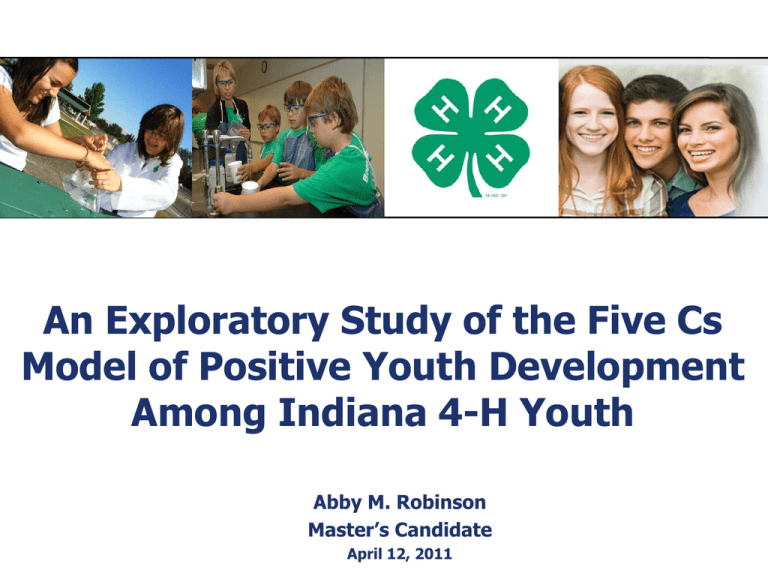4-H Youth Development Program
advertisement

An Exploratory Study of the Five Cs Model of Positive Youth Development Among Indiana 4-H Youth Abby M. Robinson Master’s Candidate April 12, 2011 Why Positive Youth Development? • Until the mid-90s, youth were viewed as problems. • Approach viewing adolescents as resources of the community, rather than problems that must fixed (Damon, 2004). • Process which prepares young people to meet the challenges of adolescence and adulthood through a series of coordinated activities and experiences (Collins, Hill, & Miranda, 2008). 2 What is Positive Youth Development? • Research aimed at finding ways to improve adolescent development and to aid students so that they may reach their full potential (Zarrett & Lerner, 2008). • Focus is on the characteristics of development that lead to positive rather than negative youth outcomes (Heck & Subramaniam, 2009). 3 Five Cs of Positive Youth Development • PYD concept is built from a framework known as the “5 Cs” of Positive Youth Development (Lerner, Lerner, & Phelps, 2009). • Five Cs Framework Competence Confidence Connection Character Caring 4 4-H Youth Development Program • Largest youth serving organization in the world (Seevers et al., 2007). • Goals Learning Development of life-skills Transformation of youth into productive members of society • 40 Developmental Assets External Internal • Eight Critical Elements of PYD Service to others; self-determination, decision making, and goal setting; positive connections with the future 5 Indiana 4-H Program • 2010 Indiana 4-H Report 210,467 youth served 2,216 organized 4-H Clubs 14,729 adult volunteers • 4-H Programming Caring adults Safe environment Opportunities to master skills and content 6 Need for Study • 4-H youth development programs have beneficial effects on youth by positively affecting development and therefore positively affecting their adulthood (Boyd, Herring, & Briers, 1992). • In the push for accountability, providing evidence of the effectiveness of youth development programs such as 4-H is essential (Boyd et al., 1992). 7 Literature Review • 4-H Study of Positive Youth Development First study to utilize the newly developed measures for PYD using the Five Cs Framework Longitudinal design Began in 2002 with fifth grade students Gathered data from student and parent questionnaires and U.S. Census data Reports contain data from youth who completed two or more years of the study • 4-H Study of Positive Youth Development Predicting Outcomes Accurately (Jelicic et al., 2007) Valid PYD Measurement (Phelps et al., 2009) Waves 1-5 (Lerner et al., 2008; Lerner et al., 2010) 8 Literature Review • Bossaer (2009) conducted the first thesis study examining elements of Lerner et al’s. (2005) PYD measures. Grades eight thru 10 from 22 counties across the State of Indiana. Active 4-H members showed higher levels of community contribution than non-4-H members. Active 4-H members reported significantly lower levels of risky behaviors (e.g., depression, tobacco and drug use, delinquent behaviors and bullying) than youth who reported limited or no 4-H experience. 9 Literature Review • Few studies have used Lerner et al’s. (2005) measures of PYD. • Limited use of the short-form version of the Positive Youth Development Student Questionnaire (Lerner, Lerner, Almerigi, Theokas, Phelps, Gestsdottir, 2008). • Few studies, including theses and dissertations, have been conducted with Lerner et al.’s (2005) PYD measure focusing on high school students. • To date, no cross-sectional studies have been conducted measuring the Five Cs among students in the 4-H youth development program. 10 Developmental Systems Theory • Developmental Systems Theory is a contemporary human development theory useful in studies of adolescent development (Kiely, 2010). • Developmental Contextualism, a core feature of DST, represents the mutually influential relations between an individual and their contextual factors (Lerner and Miller, 1993). 11 Developmental Systems Theory • Ecological Developmental Characteristics • Strengths of Adolescents • Positive Youth Development (PYD) • Contribution • Risk/Problem Behaviors 12 The DST Model Ecological Developmental Characteristics Individuals Institutions Youth-Adult Partnerships Access Contribution Competence Confidence Positive Youth Development Selection Optimization Compensation Character Caring Connection Strengths of Adolescents Risk/Problem Behaviors 13 Purpose To explore the levels of Positive Youth Development among Indiana 4-H members. 14 Research Objectives 1. Describe the levels of positive youth development (PYD) as measured by the Five Cs between 4-H and non-4-H members. 2. Describe differences in positive youth development as measured by the Five Cs between 4-H and non-4-H members. 3. Describe the relationships between positive youth development as measured by the Five Cs and selected demographic characteristics (age, gender, grade and 4-H membership). 15 Methods and Procedures • Exploratory descriptive survey design Extension Educators in every county in Indiana were asked to participate in the study. Convenience sample of youth contacted by an Extension Educator (N=453). • Short-form version of the Positive Youth Development Student Questionnaire (Lerner et al., 2008). 16 Participating Indiana Counties 17 Participants Category Gender Grade Ethnicity 4-H Membership Response f % Female 255 56.9 % Male 193 43.1% Upperclassmen 154 34.7% Lowerclassmen 290 65.3% Asian, Asian American or Pacific Islander 1 .2% Black or African American 6 1.4% Hispanic or Latino/a 5 1.1% White, Caucasian; not Hispanic 393 89.1% American Indian/ Native American 11 2.5% Multiethnic or multiracial 25 5.7% 4-H Member 200 44.2% Non-4-H Member 253 55.8% 18 Data Analysis Research Objectives 1. Describe the levels of positive youth development (PYD) as measured by the Five Cs between 4-H and non-4-H members. 2. Describe differences in positive youth development as measured by the Five Cs between 4-H and non-4-H members. 3. Describe the relationships between positive youth development as measured by the Five Cs and selected demographic characteristics: age, gender, grade and 4-H membership. Variables Independent Dependent 4-H program Confidence participation Competence (4-H/non-4-H) Connection Caring Character 4-H program Confidence participation Competence (4-H/non-4-H) Connection Caring Character Gender Confidence Competence Connection Caring Character Scale of Measurement Interval Statistical Analysis Means, Standard Deviations, Frequencies, Percentages Interval Independent t-test Nominal Pearson’s Correlation Coefficient Interval 19 Findings Research Objective 1 4-H Participants Competence 57.67 Confidence 68.31 Connection 70.74 Character 73.78 Caring 76.34 Five Cs Total PYD 69.81 Non-4-H Participants 55.55 61.31 Difference +2.12 +7.00 65.26 68.43 69.39 +5.48 +5.35 +6.95 64.42 +5.39 20 Findings Research Objective 2 Confidence N M SD t d 4-H Participant 168 68.55 15.71 -4.47** .48 Non-4-H Participant 215 61.09 16.81 Connection N M SD t d 4-H Participant 168 71.06 15.29 -3.51** .36 Non-4-H Participant 215 65.28 16.86 Character 4-H Participant Non-4-H Participant N M 168 74.07 SD t d 12.54 -3.49** .36 215 69.1 14.48 21 Findings Caring N M SD t d 4-H Participant 168 77.73 15.62 -3.66** .38 Non-4-H Participant 215 71.10 18.95 Total PYD N M SD t d 4-H Participant 168 69.42 9.68 -5.11** .48 Non-4-H Participant 215 64.42 10.93 22 Findings Research Objective 3 • Pearson correlations were used to describe the relationships between total positive youth development, each of the Five Cs and selected characteristics. Scale 1 2 3 4 5 6 7 1. Total Confidence -- 2. Total Competence .44** -- 3. Total Connection .48** .23** -- 4. Total Character .30** .17** .51** -- 5. Total Caring .18** .13** .46** .64** -- 6. Total PYD .69** .52** .78** .74** .72** -- .06 .01 .14** .14** .41** .31** -- .21** .09 .19** .19** .19** .25** .18** 7. Gender 8. 4-H Participation 8 -- * P < .05; ** p < .01 23 Implications for Practice • 4-H/Youth Development Educators from the participating counties in this study could utilize the findings as possible evidence of the contribution that the 4-H program makes in the lives of young people. • Findings could be used as evidence that the 4-H program is providing an opportunity for youth to become engaged in youth development activities and experiences which lead to positive youth outcomes. 24 Implications for Practice • Additional research is necessary to ensure that 4-H programming is indeed making an impact that is both positive and long-term which will help to make the case that 4-H youth development programs are worth sustaining. • Because individuals at the local, state, and federal levels of government will ultimately decide whether or not to fund youth development programs such as 4-H, it is critical that they be made aware of the impacts of Extension programming. 25 Recommendations for Future Research • Future studies would be strengthened by gathering data from a random sample, rather than a convenience sample, thus enhancing generalizability. • Future research should ascertain a more accurate measure of the duration, frequency, and intensity of 4-H participation. 26 Recommendations for Future Research • Future research would benefit from collecting data involving a more diverse sample among both 4-H and non-4-H participants. • Future research should include items that assess Contribution and risk/problem behaviors, key components of Developmental Systems Theory, which will then lend to findings and conclusions that can be better linked to DST. 27 Questions 28 Thank You! 29




